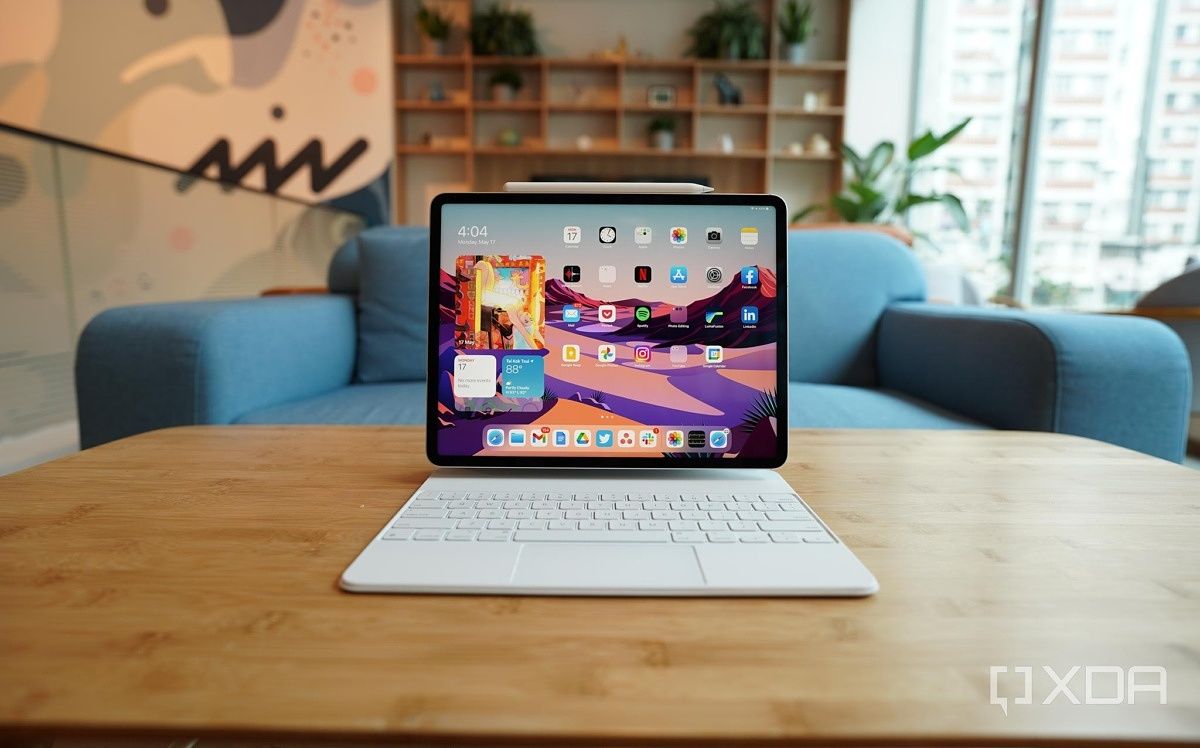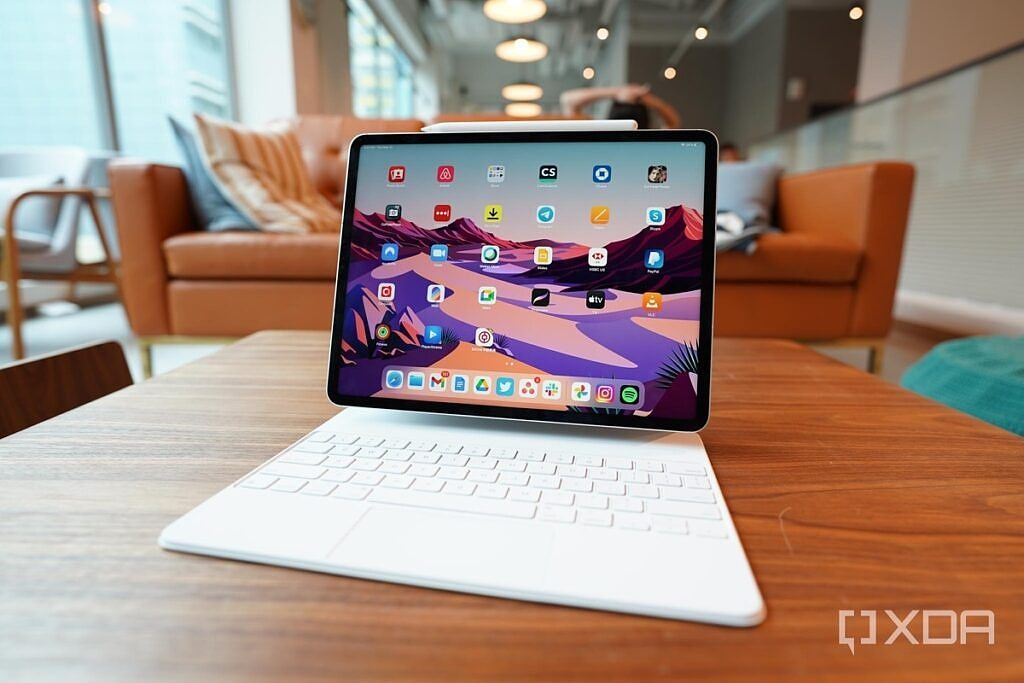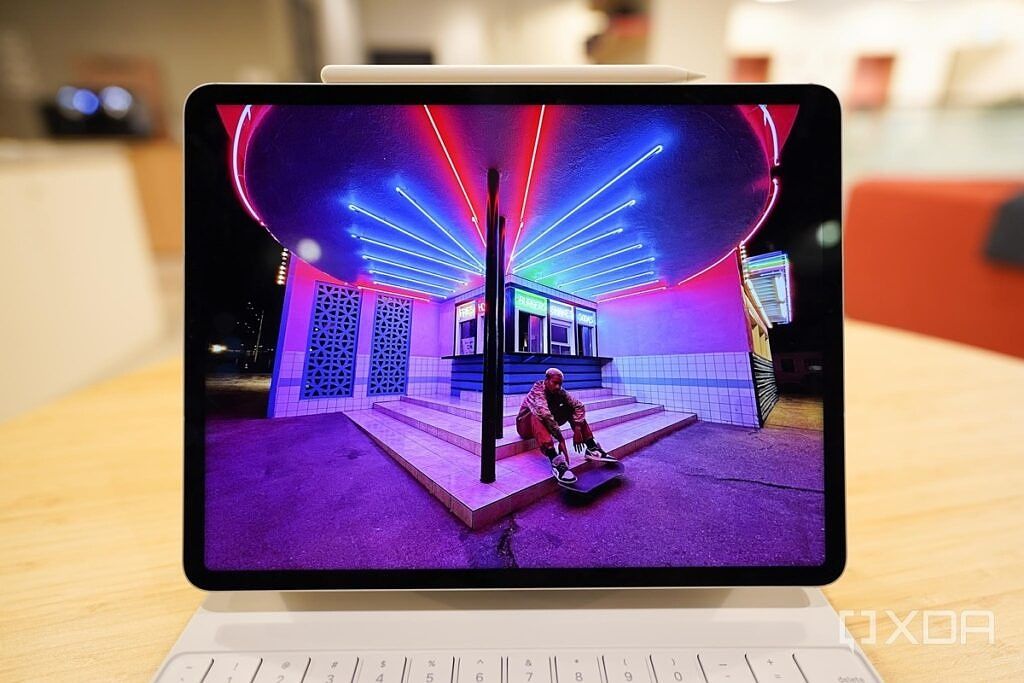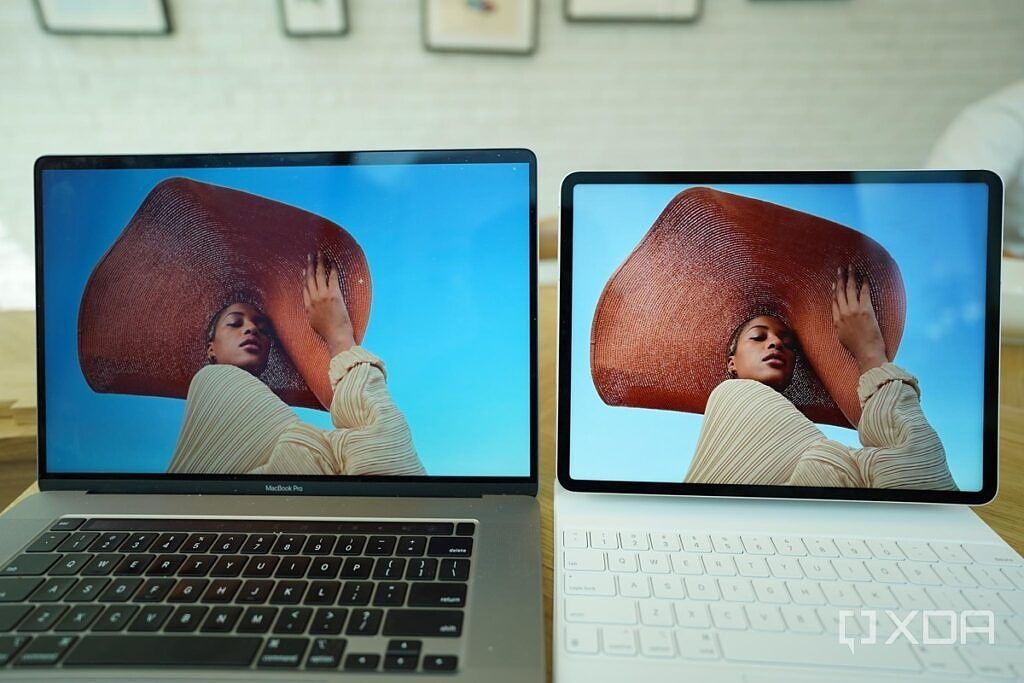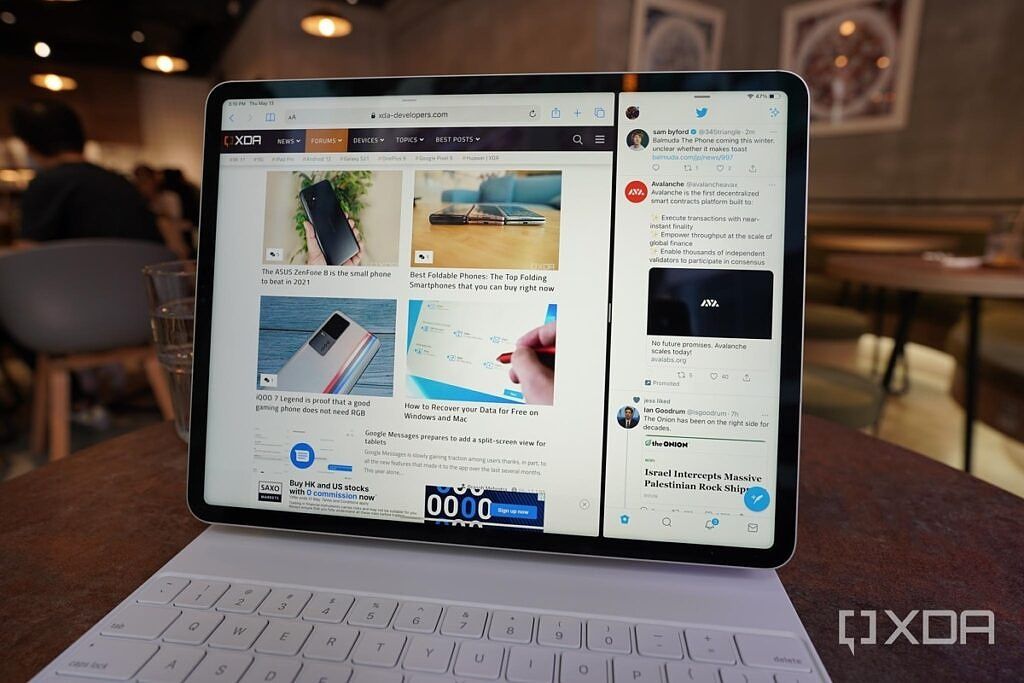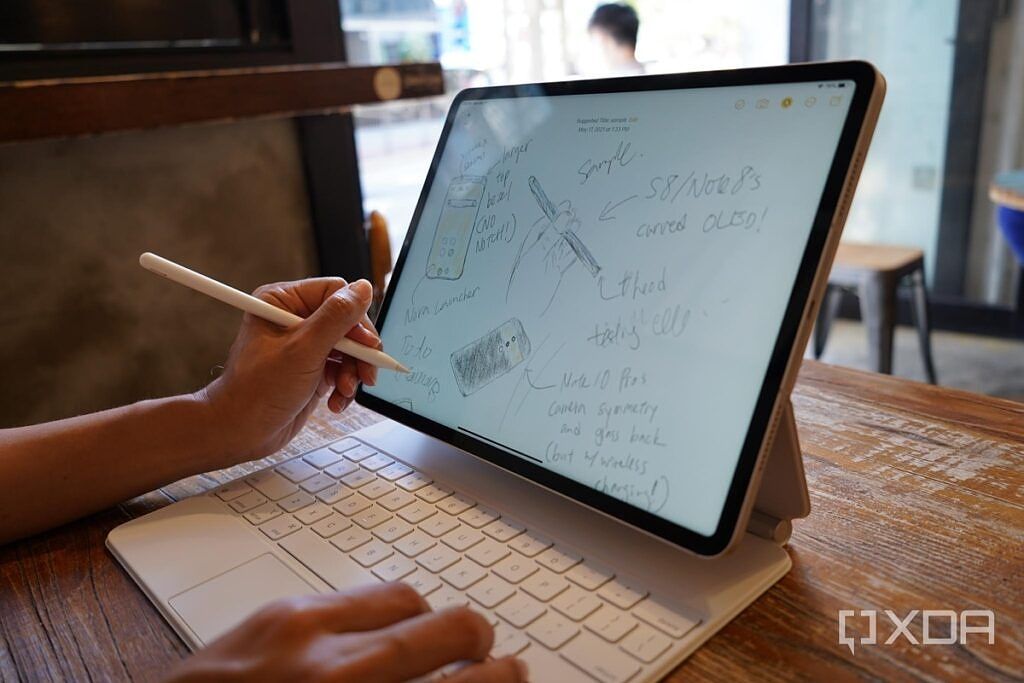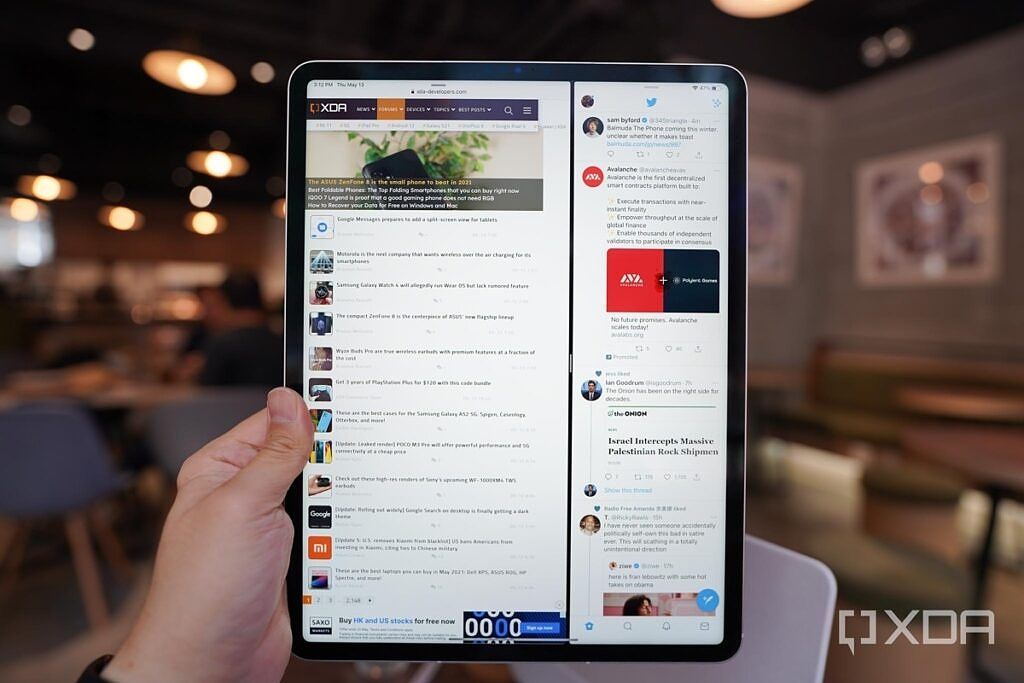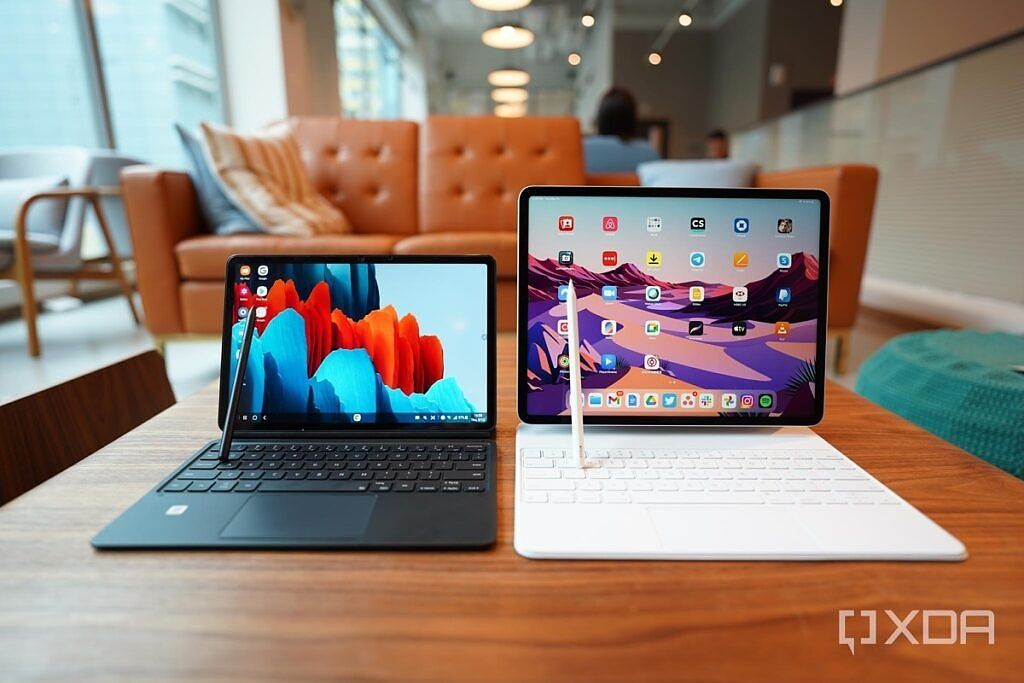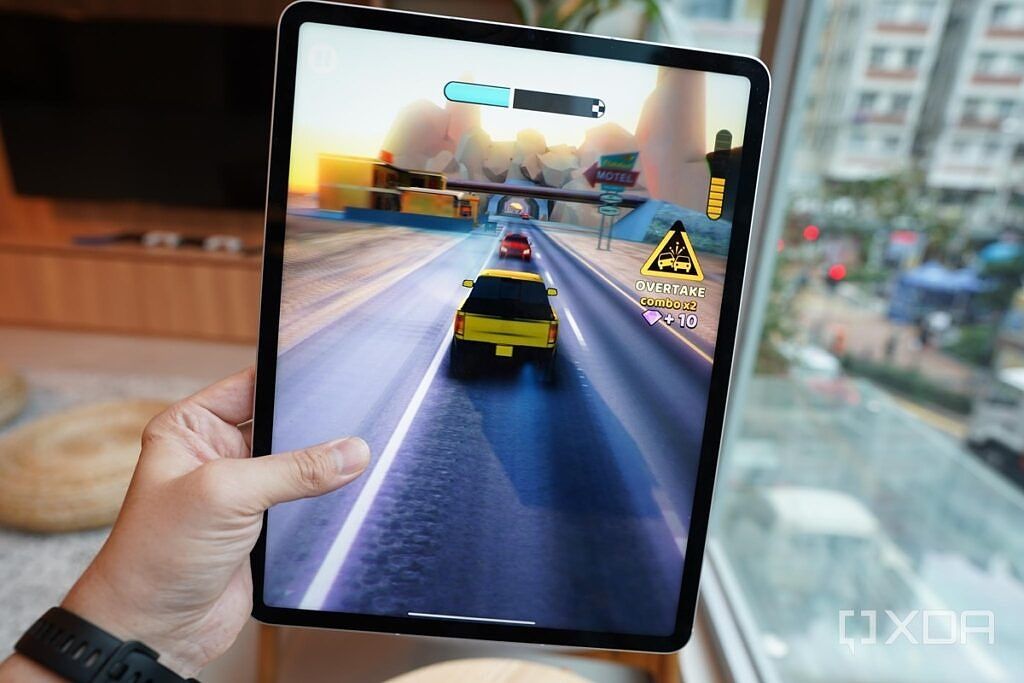Quick Links
Reviewing computers and laptops usually aren’t as fun as reviewing phones, because the former category usually sees just incremental internal upgrades (aka the “spec bump”) year on year, as opposed to smartphones, which in addition to the processor upgrade, usually sees a new design and camera tech too. So when I unboxed Apple's new iPad Pro 2021 alongside the 2021 Magic Keyboard, I felt a sense of déjà vu. Sure, Apple gave its first-party keyboard cases new colors, but for the most part, the new iPad Pro itself looks exactly like the previous two tablets.
That was before I powered on the tablet. Once I hit that power button on the new 12.9-inch iPad Pro, within 30 seconds of cycling through the setup process, I had already muttered an audible “whoa” to myself. The new iPad Pro's screen looked noticeably brighter and sharper, with more fluid animations than the iPad Air 2020, from which I was syncing my iCloud backup.
About this review: Apple Hong Kong sent me a 12.9-inch iPad Pro with 1TB storage and a Magic Keyboard to review. Apple did not have input over this article.
Hardware: It's all about the Screen and the SoC
As has been the case with the previous two models, the new 2021 iPad Pro comes in two sizes: 11-inch and 12.9-inch. If you've seen an iPad Pro in the last couple of years, then you've already seen this new model. They look mostly the same, with slim uniform bezels housing a TrueDepth camera system for Face ID, and an aluminum body with a flat chassis that has become Apple's new design language norm. This year, more than ever, the 12.9-inch iPad Pro is the more noteworthy one because that brilliant screen I teased earlier in the intro — a Mini LED display Apple's marketing team has dubbed "Liquid Retina XDR" — is exclusive to the larger model.
Used by TCL, Samsung, and LG in their high-end televisions, Mini LED is a relatively new display technology that uses very small light-emitting diodes (LED) to power the display. The 2020 iPad Pro's more traditional LCD panel featured 72 LEDs; the new 2021 iPad Pro's Mini LED features over 10,000 LEDs. What this means is that the new iPad Pro can produce far greater dynamic range, contrast, and brightness compared to the 2020 model, because there are so many more LEDs that can brighten or dim depending on what the screen is showing.
It's obvious how superior the display is on the 12.9-inch iPad Pro compared to the 2020 iPad Air and 2019 16-inch MacBook Pro
I'm no display expert, but the differences in display brilliance between the new 12.9-inch iPad Pro and my 2020 iPad Air and 2019 16-inch MacBook Pro are obvious. My iPad Air can reach a peak brightness of 500 nits, and the MacBook Pro 600 nits. Both are fine indoors but are no match compared to the 1,000 nits of peak brightness on the iPad Pro 2021.
The best OLED screens on the best phones (say, the iPhone 12 series or the Galaxy S21 series) are comparable to the iPad Pro's Mini LED screen, but the latter gets brighter, doesn't suffer from burn-in, and is more suitable for productivity machines.
Just how powerful is the M1 in the iPad Pro 2021?
The other big upgrade to this year's iPad Pro line is the use of Apple's M1 silicon, the ARM-based SoC that made its debut in the MacBook Air and Mac Mini a few months ago to critical acclaim because they basically beat Intel-powered Macs in both real-world and benchmark tests.
My testing with the 2021 iPad Pro showed the same impressive results. In one test, I exported a 26 minute, 38 second long 4K/30fps video from iMovie on the new iPad Pro, a 2020 iPad Air (powered by the same 5nm SoC used in the iPhone 12 series), and a 2019 Intel i9 MacBook Pro with 32GB of RAM. The M1-powered iPad Pro finished first, rendering the video in 13 minutes and 5 seconds. The iPad Air finished second at 15 minutes and 4 seconds. The i9 MacBook Pro (which I paid $3,300 for) took 30 minutes and 18 seconds.
The 2021 iPad Pro showed the same impressive performance as Apple's M1-powered MacBook
On GeekBench, the 2021 iPad Pro's Multi-Core score was more than double that of the 2020 iPad Air (with its A14 Bionic) and the ZTE Axon 30 Ultra (powered by Qualcomm's Snapdragon 888). I did not run Geekbench on my Intel i9 MacBook Pro (because the app cost $10), but other testers have, and it lost to the 2021 iPad Air too.
There are three more noteworthy hardware upgrades: Both 2021 iPad Pro tablets get more capable USB-C ports with Thunderbolt support; they both support 5G connectivity in the cellular models; and they both get front-facing camera upgrades to a 12MP ultra-wide camera, which is put to good use (I'll explain in the next section).
Other parts of the iPad Pro 2021 remain the same as before, from the "ProMotion" refresh rate (120Hz), the display resolution, the excellent quad-speaker system, and the main camera system that includes a wide, ultra-wide, and LIDAR scanner.
Software: iPadOS 14.5 takes Center Stage
My new iPad Pro came out of the box with iPadOS 14.5 preinstalled, but within two days, I got a software update to 14.5.1. As far as I know, almost all the big changes to iPadOS 14.5 are the same ones brought to iOS 14.5, such as Siri better understanding my music listening habits; new emojis and Siri voices; and the big one that's got Mark Zuckerberg so mad — app tracking transparency.
The new iPad Pro is an excellent, best-in-class tablet, with better animations, UI, and a more developed app ecosystem than anything in the Android or Windows space.
The feature exclusive to iPadOS software is a trick called "Center Stage," which uses the new iPad Pro's M1 chip and the ultra-wide front-facing camera to intelligently track the user's face during video calls. This means I can move around during the call, and the video will follow my movement and keep me framed in the center as much as possible. If a second person steps into the frame, then the M1 accounts for both of our faces and adjusts the frame to keep us both in the picture. It works quite well, as the sample below shows.
Other than Center Stage, the software experience on the 2021 iPad Pro feels fundamentally the same as the 2020 or 2018 iPad Pros. This means the new iPad Pro is still an excellent, best-in-class tablet, with better animations, UI, and a more developed app ecosystem than anything in the Android or Windows space. Using the tablet with a keyboard as a computer replacement can be hit or miss since you can still open at most two apps at the same time (three if you want to be generous). I'll explain more in the next section.
Can you use the new iPad Pro with Magic Keyboard as a computer replacement?
Ever since Apple debuted it in 2015, the iPad Pro has been billed as a potential computer replacement. This claim was laughable at first when the tablet could only show one app at a time and didn't have a proper file management system. Things started to get better by 2017 or so, when Apple introduced split-screen multitasking for iPads, and then eventually a file management system in 2018.
I actually used an iPad Pro as my main work machine for most of 2018. Granted, I was entirely an independent freelance writer at the time, so the only apps I needed for work were Google Docs, Safari, and Gmail. Being limited to just two apps on-screen at once didn't hold me back much, as I never needed more than two apps at once anyway. I didn't have regular video calls, nor did I need to log into chat apps like Slack.
But today, my work situation is more complicated and dynamic, and even the new iPad Pro can no longer cut it as my main work machine. I work with a team at XDA, which means I need to be on Slack; there are regular video calls; and I no longer just write words — I also take product shots, edit those photos, upload to servers, add captions, among other tasks like producing videos. Being able to open just two apps at once is too limiting, as Slack itself would always need to be opened during my work hours. I can have a third app opened in "Slide Over" mode, which sees the app hanging off-screen, ready to be dragged into the screen at a moment's notice, but it's still not as easy as just having three resizable windows which I can do on real computers or even Samsung's Galaxy Tab S7.
Third-party video conferencing apps such as Zoom or Google Meet can also be hit and miss on the 2021 iPad Pro, since going into split-screen view often results in the camera turning off or kicking me out of the call.
And while LumaFusion is in my opinion the best video editing app on any mobile device, it's still no match for desktop-class video editing software like Final Cut Pro or Adobe Premiere. Simply put, I can no longer just carry an iPad Pro on a week-long trip and expect to be able to do all my work with ease as I could back in 2018.
The new iPad Pro can no longer cut it as my main work machine
It's a shame iPadOS is still a bit limiting, because the iPad Pro's UI animations, display brilliance, and Magic Keyboard are so damn good. The latter requires a separate purchase, and it's definitely overpriced compared to more affordable third-party keyboards, but if money is no object, it's by far the best slim keyboard folio case I've ever used with any tablet. Keys are evenly spaced with excellent travel, and despite the trackpad being relatively small, it's more accurate than most Windows laptop trackpads I've tested (Dell XPS 13, Huawei MateBook X Pro, etc). I also love that the keyboard elevates the iPad off the table slightly.
If there's a silver lining, it's that this might change in the near future. Apple made a curious decision by giving the 1TB and 2TB models of the iPad Pro 16GB of RAM, a huge jump from the maximum 6GB RAM used in the 2020 iPad Pros. Apple has never cared much about cramming more RAM into its iPhones and iPads, so this M1-powered iPad Pro suddenly having 16GB makes many industry insiders wonder if Apple is planning something big — perhaps iPadOS is getting better multi-tasking capabilities in the near future? Or maybe more Mac apps such as Final Cut Pro will make their way to the iPad?
I sure hope so, because as it is now, the M1 chip is almost too powerful for "just" an iPad running a tablet version of iOS.
Can you use the iPad Pro with Apple Pencil as a creativity machine?
I've been a fan of the Apple Pencil for years, and I'm still a fan of using it with the new 2021 iPad Pro. Whether it's jotting down notes in Apple's default Notes app or sketching in the highly popular Procreate app, the large 12.9-inch canvas with a 3:2 aspect ratio and 120Hz refresh rate makes writing highly enjoyable. Apple doesn’t reveal the exact number of pressure sensitivity levels of the Apple Pencil, but professional artists that have tested it say it’s similar to the Surface Pen’s reported 4,096 levels of sensitivity.
Whatever the case, I used the Apple Pencil to do some sketches and found the experience to be lag-free and similar enough to drawing on paper.
The Apple Pencil's finer tip (compared to our fingers) also makes it useful for photo and video editing. In Lightroom, I can make more precision crops and spot corrections.
I'm still a fan of using the Apple Pencil with the new 2021 iPad Pro
Using the iPad Pro for fun, tablet-ey things
I already said earlier that Apple's iPad Pro is the best tablet on the market — an opinion shared by most reviewers — so it should come as no surprise that this new iPad Pro knocks the tablet experience out of the park. Most of this has to do with the fact that app developers are just more eager to build for iOS/iPadOS than Android or Windows because Apple users on average spend more money on apps and iPads are really abundant out in the wild. But the interest from developers is also because of the hardware: the iPad Pro's LIDAR (Light Detection and Ranging) scanner makes AR apps run far more accurately. For example, measuring the distance between walls or floor to ceiling of interior buildings is far more accurate on an iPad Pro with LIDAR than with similar apps on an Android phone. Below, you can see that the iPad Pro's LIDAR scanner is able to accurately detect the curvy surface area of the wooden table.
There are dozens of excellent AR apps in Apple's app store that make good use of the real-world environment, such as AR Animals and Angry Birds. In my furniture-filled co-working space, the iPad Pro had no problem displaying virtual objects on counters, next to and around chairs and sofas.
The new iPad Pro's quad-speaker system pumps out the best sound on any tablet I've used, which, coupled with the gorgeous large screen, makes for a top-notch gaming or Netflix binging machine. Smooth scrolling animations also make the tablet ideal for reading in bed.
The new iPad Pro pumps out the best sound on any tablet I've used
Battery Life
While the M1-powered MacBook Air saw drastic improvements in battery life over previous Intel versions because the ARM-based mobile SoC is much more efficient than Intel’s processors, the battery life of the new 2021 iPad Pro isn’t that much different from the 2020 models, because iPads had always run on efficient ARM-based SoCs already. Apple says this year’s 12.9-inch iPad Pro can last about 10-11 hours of use on a single charge, but my usage came up short. I haven’t fully pushed the tablet from 100 to 0% in one go yet, but on several four-hour use sessions consisting of writing on WordPress with Slack running on the side and streaming Spotify, I’d see the battery drop by close to 50%. So for me, this feels like a machine that can get to eight hours, maybe nine, but not ten.
At least charging it is easy because the iPad Pro charges via USB-C instead of the annoying Lightning cable.
[sc name="pull-quote" quote="The 2021 iPad Pro is easily the best tablet money can buy right now"]
Conclusion: The new iPad Pro is the best tablet, but iPadOS needs to do more
Considering that it’s just about the general consensus in tech media that the iPad has been the best tablet in the market and the M1 SoC more than lived up to the hype, it was almost a foregone conclusion that this M1-powered iPad Pro would be an awesome machine and easily the best tablet in 2021.
But here’s the thing: I said that about the 2015, 2017, 2018, and 2020 iPad Pros too. Apple’s A-series silicon and iOS apps are so well optimized that even the 2018 iPad Pro would still run flawlessly today. For most people who aren’t exporting 4K videos regularly, they’d be hard-pressed to tell where the 2021 iPad Pro improves on the 2018 iPad Pro other than the screen looking better. iOS apps still run great on the four-year-old iPhone 8, let alone the 2021 spec’ed out iPad Pro.
This is why Apple insiders are all wondering if Apple has something more planned for the iPad Pro software-wise. Because the M1 really is too powerful for just an iPad.
Apple prices this 2021 iPad Pro like it’s more than just a tablet too. Sure, the base model starts at $799, seemingly a very affordable price for a new Apple product, but this is for the 11-inch model without a Mini LED screen or cellular capabilities and a measly 128GB of storage. You also shouldn’t buy an M1-powered iPad Pro and use it just as a tablet, so you’re going to want a keyboard with it too. Throw in the Apple Pencil and this $799 price jumps to well over four digits. The priciest 2021 iPad Pro (12.9-inch, 2TB storage, WiFi + cellular connectivity) costs $2,099 (add in the accessories and it’s closer to $2,400).
So yeah, Apple's best tablet is priced firmly in flagship laptop category. If you’re looking for just a tablet to do bedtime reading or streaming Netflix, I wouldn’t recommend buying the 2021 iPad Pro. Instead, get the far better value iPad Air or even a Galaxy Tab S7 instead. But for people who actually plan to do work off this machine (digital illustrators, writers who just need to type words, etc), I’d argue the 2021 iPad Pro is worth it because they’d be getting a machine that excels at both work and play.
And if Apple actually brings over Mac apps and makes iPadOS more capable? Then I’d argue it’s a better buy than a laptop. For me, if I can run Final Cut Pro and open apps in floating resizable windows on this machine, it’d immediately replace my MacBook Pro with an iPad Pro as my main work machine.
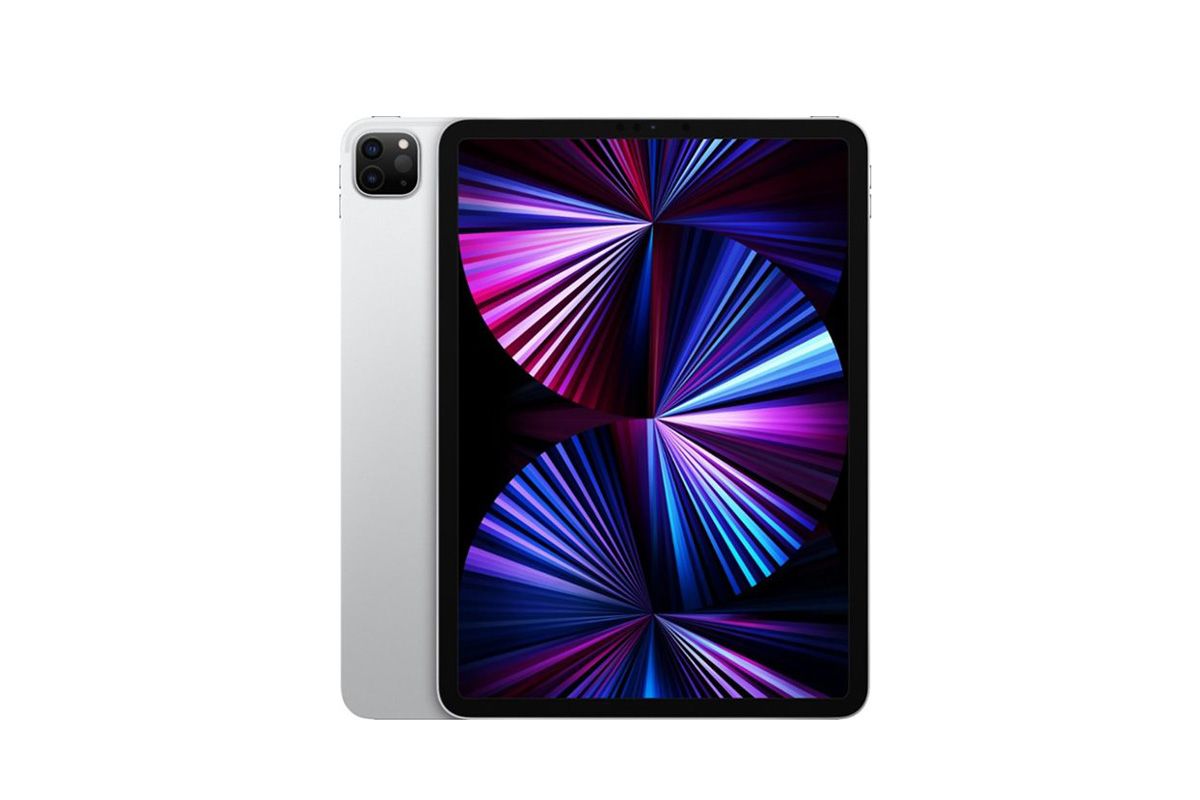
Apple iPad Pro 11-inch (2021)
The 11-inch model of the iPad Pro may not have that Mini LED screen, but it still has the game-changing M1 processor and comes in a highly portable size.
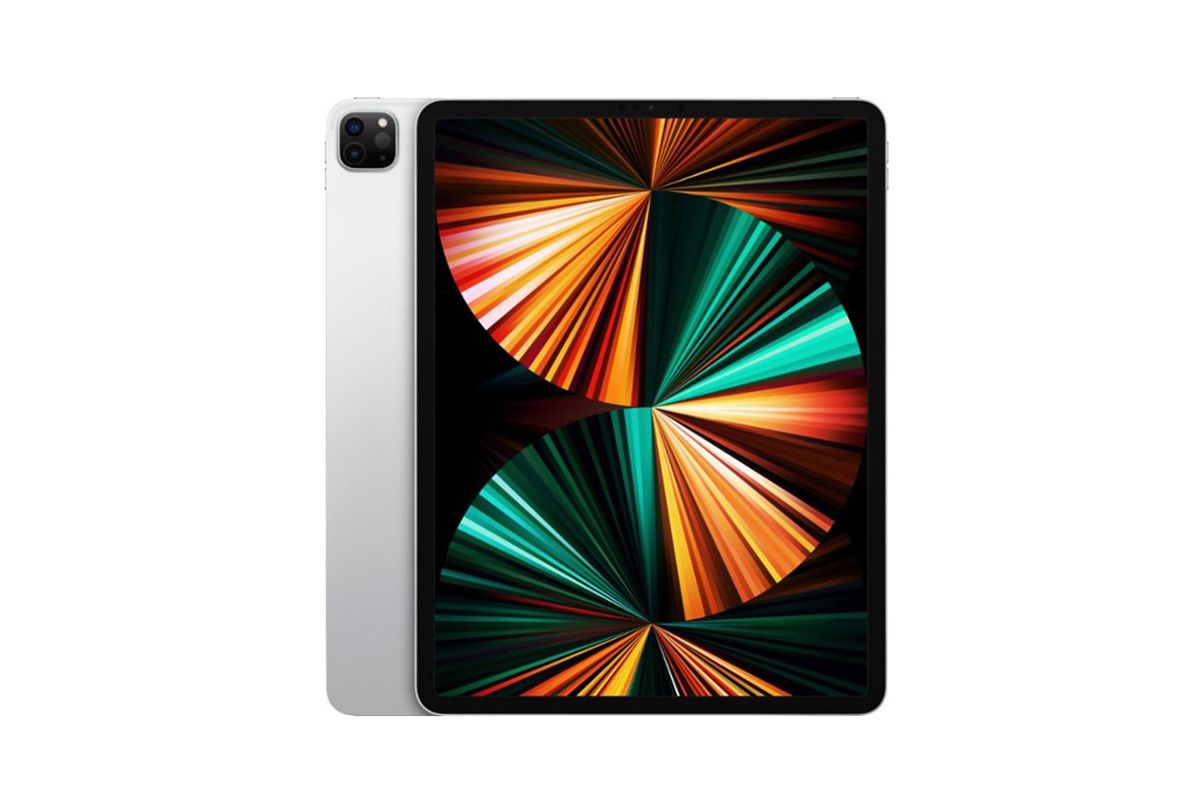
Apple iPad Pro 12.9-inch (2021)
The screen on this 12.9-inch iPad Pro has to be seen to be believed. Add the M1 chip and this is almost too powerful for just an iPad.
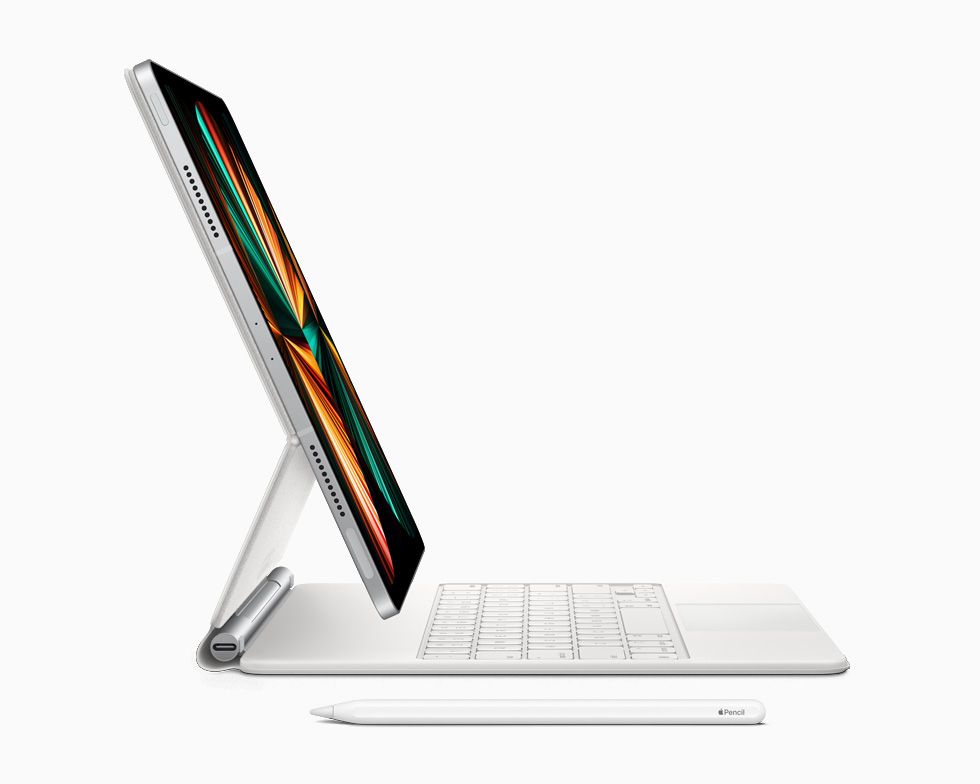
Apple Magic Keyboard for iPad Pro 12.9-inch
If you want to use the iPad Pro to its full potential you will need a keyboard, and Apple's official Magic Keyboard has the best typing and trackpad experience on a relatively thin folio case.

